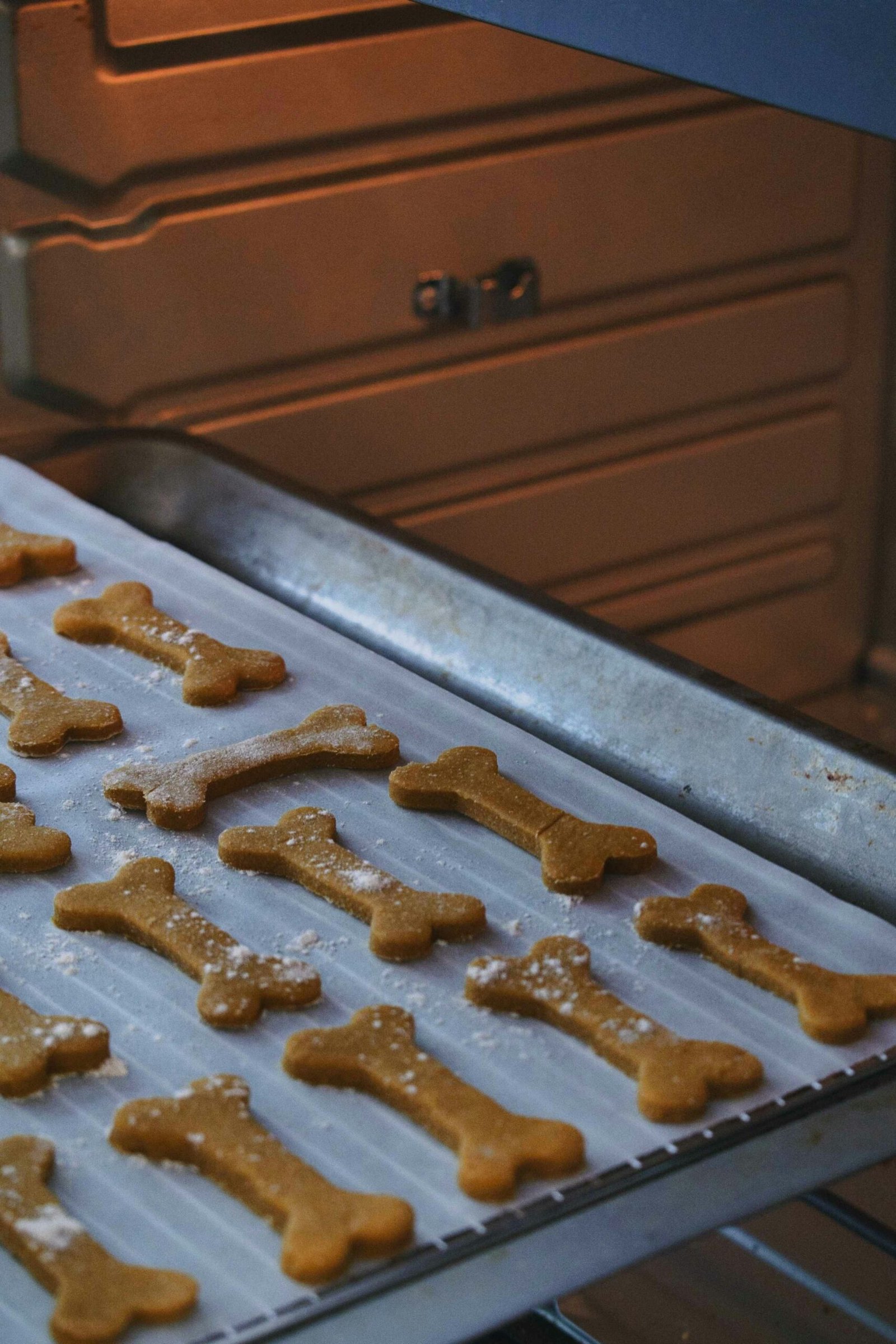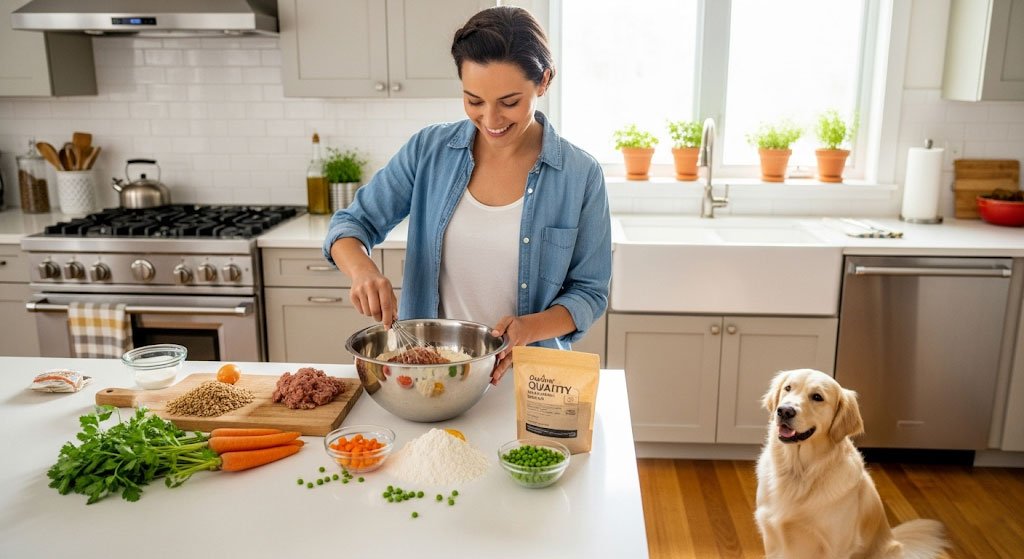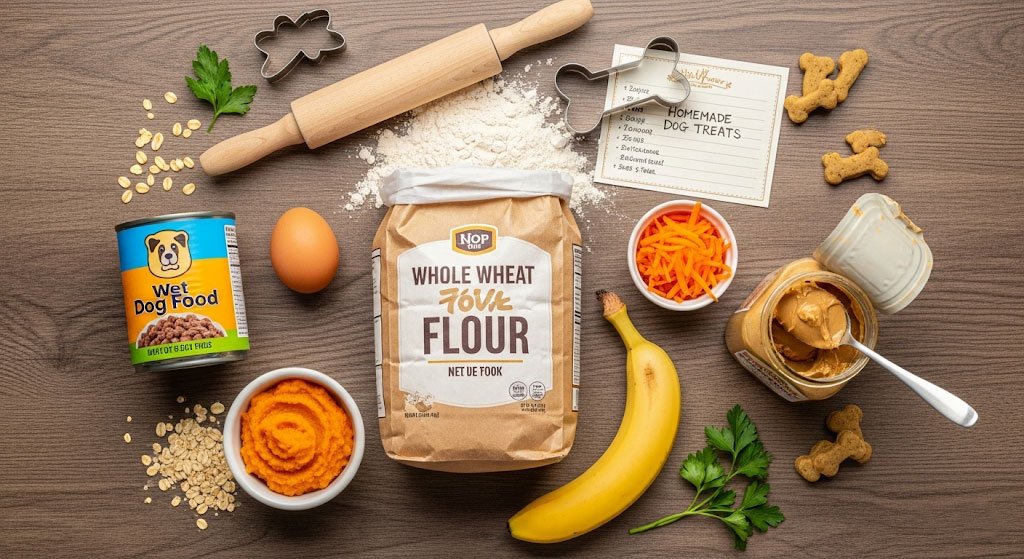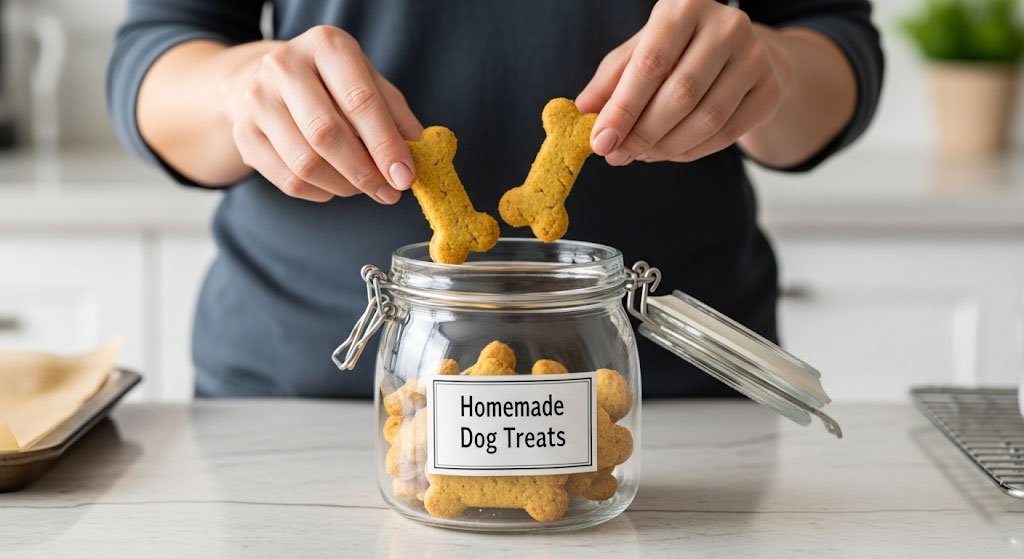Baking Wet Dog Food Into Treats: The Ultimate Guide to Making Healthy, Delicious Snacks for Your Dog

Introduction to Baking Wet Dog Food Into Treats
Baking dog treats using wet dog food is an increasingly popular trend among pet owners who are conscious about their furry friends’ nutrition. This innovative approach allows pet parents to create healthy, delicious snacks that cater specifically to their dogs’ dietary needs. Using wet dog food as a base ingredient not only provides the necessary moisture and flavor that dogs adore but also opens up a myriad of possibilities for flavor combinations and nutritional enhancements.
Homemade dog treats offer several advantages over commercial alternatives. One of the primary benefits is the control it grants owners over the ingredients used. When baking with wet dog food, owners can ensure that the treats are made with high-quality, fresh components, steering clear of artificial additives and preservatives typically found in store-bought options. Additionally, customizing the treats paves the way for addressing specific dietary requirements, whether it’s for dogs with allergies, sensitivities, or specific health concerns. This tailored approach not only enhances the dog’s eating experience but may also improve their overall health and well-being.
Furthermore, the process of preparing homemade dog treats can strengthen the bond between pet and owner. Engaging in a baking activity allows owners to spend quality time with their pets, making the final product more rewarding. Given the growing concern over pet health, more individuals are embracing the concept of DIY dog treats, recognizing that they can craft wholesome snacks that are both enjoyable and beneficial. In light of these factors, baking dog treats using wet dog food has emerged as an effective way to ensure dogs have access to nutritious and flavorful snacks.
Understanding Wet Dog Food
Wet dog food, often available in cans or pouches, is a popular choice among pet owners due to its appealing texture and flavors. Comprising primarily of meat, vegetables, and grains, wet dog food is formulated to deliver essential nutrients that support canine health. The moisture content in wet dog food typically exceeds 75%, making it an excellent source of hydration for dogs, particularly those who may not drink enough water on their own. This moisture also contributes to the palatability of the product, which can be beneficial for dogs that are picky eaters or suffering from health issues that affect their appetite.
Nutritionally, wet dog food often contains higher protein levels compared to dry kibble, as the primary ingredients usually feature real meat or meat by-products. Additionally, it may include vitamins and minerals to ensure a complete and balanced diet. However, it’s important for pet owners to carefully read ingredient labels, as the quality and type of ingredients can vary significantly between brands. Opting for brands that prioritize whole ingredients and include limited fillers can improve the overall quality of a dog’s diet.

Wet dog food serves several advantages over its dry counterpart. For example, its enhanced aroma is likely to entice dogs, increasing the chances they will eat if they are less enthusiastic at mealtime. Moreover, for dogs with dental issues or elderly dogs that may struggle with chewing hard kibble, wet food provides a softer alternative that is easier on their jaws and teeth. It can also be beneficial for dogs with certain medical conditions like kidney disease, where increased moisture intake is essential for their health. In essence, incorporating wet dog food into a dog’s diet can enhance their overall well-being while catering to their individual preferences and needs.
Choosing the Right Ingredients
When preparing to bake treats for your dog using wet dog food, the selection of ingredients plays a crucial role in ensuring that the final product is both nutritious and palatable. The first step in this process is to thoroughly read and understand the ingredient labels of wet dog food. Opting for products that list high-quality proteins as the first ingredients can significantly enhance the nutritional value of your treats. Proteins should ideally come from identifiable meat sources, such as chicken, beef, or fish, rather than ambiguous terms like “meat by-products.” This ensures that your dog is getting real, wholesome nutrition.
In addition to protein, it is essential to avoid wet dog foods that contain harmful additives, artificial preservatives, or fillers. Common offenders include ethoxyquin, BHA, and BHT, which can have adverse effects on your dog’s health. Instead, look for wet dog foods that are made with natural ingredients and devoid of synthetic chemicals. This not only makes the treats healthier but also aligns with a holistic approach to your dog’s overall diet.
Moreover, consider incorporating dog-friendly additions to the baked treats for extra flavor and nutritional benefits. Fruits such as blueberries, bananas, or apples (without seeds) can provide essential vitamins and antioxidants. Similarly, certain vegetables like carrots, sweet potatoes, and spinach can be excellent choices to enhance the nutrient profile of your treats while maintaining a delightful taste. Whole grains, such as oats or brown rice, can also serve as nutritious fillers, ensuring the treats achieve the right texture while providing additional fiber. By thoughtfully selecting both the wet dog food and supplementary ingredients, you can create a range of healthy, enticing treats that your dog will love.
Tools and Equipment Needed
When it comes to baking wet dog food into tasty treats, having the right tools and equipment is essential to simplify the process and ensure a successful outcome. Below is a list of necessary items that every dog treat baker should consider incorporating into their kitchen arsenal.
First and foremost, you will need a set of mixing bowls. A variety of sizes is beneficial; larger bowls are ideal for combining wet and dry ingredients, while smaller bowls can be used for measuring out specific components such as herbs, spices, or supplements that enhance the nutritional value of the treats.
Next, acquire high-quality measuring spoons and cups. Accurate measurements are crucial when it comes to baking, especially in ensuring that the final treats maintain the desired texture and flavor. Investing in stainless steel or plastic measuring tools can improve durability and ease of cleaning.

Baking sheets are another essential item on the list; opting for non-stick versions or silicone baking mats can prevent the treats from sticking, allowing for easy removal once they have finished baking. Furthermore, silicone molds are highly recommended for creating fun shapes and stimulating your dog’s interest in the treats. These molds often have flexible designs that facilitate effortless removal of the final product.
Additional specialized tools may include a food processor or blender for mixing ingredients more thoroughly or creating a smoother consistency, particularly when blending wet dog food into the treat mixture. A rolling pin can be useful for flattening dough evenly, and cookie cutters enable you to create uniform shapes.
Having these tools and equipment at hand will not only streamline the baking process but also enhance the overall quality of the dog treats you produce, ensuring that your furry friend enjoys a delicious and nutritious snack.
Basic Recipe for Baking Dog Treats
Creating healthy and delicious dog treats using wet dog food is a straightforward process that can easily be done at home. To start, gather the necessary ingredients: one cup of high-quality wet dog food, two cups of whole wheat flour, one egg, and a tablespoon of peanut butter. This basic recipe is both nutritious and appealing for your furry friend.
Begin by preheating your oven to 350°F (175°C). In a mixing bowl, combine the wet dog food and peanut butter thoroughly to ensure a smooth mixture. Next, crack the egg into the bowl, and mix well until fully integrated. Gradually add the whole wheat flour, mixing until a thick dough forms. Depending on the consistency of your dough, you may need to adjust the flour slightly. If it appears too wet, add a little more flour; conversely, if it is too dry, consider adding a small amount of water or additional wet dog food.
Once your dough reaches the right consistency, turn it out onto a floured surface. Knead the dough gently for a few minutes and then roll it out to about half an inch thick. Using cookie cutters, cut the dough into shapes that appeal to your dog, or simply cut it into squares for ease of preparation. Place the cutouts on a baking sheet lined with parchment paper, making sure they are spaced apart to allow for even baking.
Bake the treats in your preheated oven for approximately 25 to 30 minutes or until they are golden brown and firm to the touch. After baking, allow the treats to cool completely before serving them to your dog. This basic recipe can easily be adjusted according to your dog’s size or specific dietary needs by modifying ingredient quantities or adding other healthy elements, such as pumpkin puree or mashed bananas.
Flavor Variations and Customizations
Exploring various flavor combinations for your homemade dog treats can enhance the enjoyment you and your pet experience during snack time. By using different types of wet dog food, you can create a diverse range of flavors that cater to your dog’s unique palate. Mixing wet dog food with safe additives can yield treats that are not only delicious but also packed with nutritional value.
One popular option is to combine wet dog food with peanut butter. Dogs generally love this flavor, and it can serve as a great source of protein and healthy fats. Ensure that you use unsweetened, xylitol-free peanut butter, as certain additives can be harmful to dogs. Another excellent additive is pumpkin puree, which can enhance the texture of your treats while providing fiber and vitamins. Pumpkin is known for its digestive benefits, making it a particularly healthy choice.

Additionally, applesauce can be an interesting ingredient to mix in with your wet dog food. It provides natural sweetness and moisture, which is vital for maintaining the proper consistency of your treats. Always opt for unsweetened applesauce, as added sugars should be avoided in your dog’s diet. You might also consider introducing flavors such as blueberries or carrots to the mixture; these are not only appealing but also loaded with antioxidants and nutrients beneficial for your dog’s health.
While experimenting with flavors, it is essential to ensure that all ingredients are safe for canine consumption. Avoid using any spices, especially those that are harmful to dogs, such as garlic or onion powder. Always prioritize your dog’s health by sticking to dog-friendly ingredients. This way, the creative process of customizing treats can be both enjoyable and safe.
Storing and Preserving Homemade Dog Treats
When it comes to preserving the quality and freshness of homemade dog treats, proper storage techniques are essential. In order to maximize the shelf life of these delicious snacks, it is important to consider the ingredients used as well as the method of preparation. Generally, treats made from wet dog food, combined with other ingredients, need to be stored properly to prevent spoilage and maintain their nutritional benefits.
Airtight containers are often the best option for storing homemade dog treats. These containers prevent exposure to air, which can lead to stale or spoiled treats. For those treats with higher moisture content, refrigeration may be a necessary measure. By placing treats in the fridge, you can significantly extend their freshness, although it is advisable to use them within a week for the best quality.
The longevity of your homemade snacks greatly depends on their composition. For instance, treats featuring higher levels of fat or moisture may not last as long as drier options, such as those baked to a crumbly finish. Generally, baked treats can remain fresh for up to two weeks when stored in a cool pantry. In contrast, refrigerated treats should ideally be consumed within one week to prevent them from becoming too soft or unpalatable.
Another great way to prolong the shelf life even further is to freeze the treats. Most homemade dog treats can be safely frozen for up to three months. This not only helps to lock in freshness but also allows you to prepare larger batches without the immediate pressure to consume them. Simply place treats in a well-sealed freezer bag or an airtight container before placing them in the freezer.
By following these straightforward storage guidelines, you can ensure that your homemade dog treats remain fresh and enjoyable for your beloved pet, maximizing their nutritional value and taste with every bite.
Feeding Guidelines and Treat Limitations
When it comes to offering homemade treats to your dog, particularly those crafted from wet dog food, it is essential to adhere to specific feeding guidelines to ensure your pet’s health and well-being. The quantity of treats a dog can enjoy will significantly depend on various factors including its size, age, activity level, and overall diet. As a general rule of thumb, treats should not compose more than 10% of your dog’s daily caloric intake. This approach helps maintain a balanced diet and prevents excessive calorie consumption that could lead to obesity.
For smaller dogs, it is advisable to limit treats to one or two small pieces daily, while larger breeds may be able to handle a few more, depending on their overall caloric needs. Age also plays a crucial role; puppies require more energy for growth and can consume slightly more treats than adult dogs. Senior dogs, however, may need fewer treats due to lower activity levels and specific dietary requirements. Always consider factors such as their weight, age, and health status when determining treat portions.
Moreover, introducing new treats should be done with caution. Gradually incorporating wet dog food-based snacks allows you to monitor your dog’s response. Observe for any signs of adverse reactions, such as digestive issues or allergic responses. If you notice any unusual behavior or health concerns, it’s wise to consult with a veterinarian before continuing with treats. This vigilant approach ensures that your furry friend remains happy and healthy while enjoying the occasional homemade snack.
Conclusion and Encouragement to Bake for Your Dog
In conclusion, transforming wet dog food into tasty treats offers numerous advantages for both pet owners and their canine companions. This method enables you to ensure that your dog receives nutritious snacks made with ingredients you can trust. By baking these homemade treats, you help avoid the unknown additives and preservatives often found in commercial options. Moreover, the process of baking is not just beneficial from a nutritional standpoint; it is also a way to bond with your dog. Your pet will appreciate the effort and love you put into creating their snacks, leading to happier, healthier mealtime routines.

Moreover, embarking on this baking journey allows you to explore your culinary creativity. There are countless recipes and variations to try, ensuring that your dog will always have something to look forward to. Whether you choose to incorporate their favorite flavors or experiment with new textures, the possibilities are endless. Each batch of treats you bake can be tailored specifically to your dog’s preferences, further enhancing their enjoyment and satisfaction.
As you venture into the world of baking, consider sharing your delicious creations on social media platforms or within dog owner community forums. Not only does this allow you to showcase your baking skills, but it also contributes to a supportive community of fellow pet lovers seeking new ideas and inspiration. By sharing tips, recipes, and even photos of your dog enjoying the treats, you can encourage others to join you in this rewarding experience.
Ultimately, the joy of providing healthy, homemade snacks for your dog is unmatched. We encourage you to gather your ingredients and start baking today. Your furry friend will undoubtedly thank you with wagging tails and excited barks.




